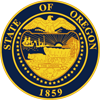
 Oregon
Oregon
Oregon has a constitutional supermajority requirement to raise taxes under Article IV Section 25 of the Oregon State Constitution and a statutory appropriations limit under Oregon Revised Statutes, Chapter 291, Section 349. The constitutional supermajority requirement to raise taxes was enacted in 1996 through legislative referendum and imposes a 3/5 supermajority legislative vote requirement to pass bills for raising all types of revenue. This supermajority requirement can be overridden by a 3/5 supermajority vote.
The statutory appropriations limit was originally enacted in 1979 but was replaced in 2001 to apply to all appropriations including all activities set under the Government Accounting Standards Board, GASB, and post-secondary education funded by the state government. It limits appropriations to 8% of state personal income. This appropriations limit exempts debt-financed capital projects, appropriations of federal funds, higher education fee remissions, donations to state agencies, and any revenues or expenditures authorized by a public vote.
| Year | Inflation-adjusted Actual Spending |
|---|---|
| 1992 | 13,791,720,000 |
| 1993 | 13,713,010,000 |
| 1994 | 12,902,580,000 |
| 1995 | 12,867,640,000 |
| 1996 | 15,571,380,000 |
| 1997 | 15,490,130,000 |
| 1998 | 16,554,440,000 |
| 1999 | 11,598,340,000 |
| 2000 | 20,095,500,000 |
| 2001 | 17,392,250,000 |
| 2002 | 18,588,960,000 |
| 2003 | 17,711,010,000 |
| 2004 | 20,996,620,000 |
| 2005 | 19,230,470,000 |
| 2006 | 20,119,040,000 |
| 2007 | 19,753,750,000 |
| 2008 | 21,058,800,000 |
| 2009 | 22,516,890,000 |
| 2010 | 28,761,110,000 |
| 2011 | 28,569,790,000 |
| 2012 | 21,764,250,000 |
| 2013 | 20,370,720,000 |
| 2014 | 26,466,690,000 |
| 2015 | 29,773,610,000 |
| 2016 | 29,105,600,000 |
| 2017 | 31,643,560,000 |
| 2018 | 31,048,140,000 |
| 2019 | 32,124,370,000 |
| 2020 | 35,671,440,000 |